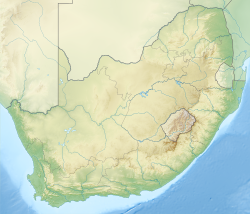False Bay
| False Bay Valsbaai |
|
|---|---|

Eastern False Bay coast aerial view looking somewhat south of east: Gordon's Bay (left) to Cape Hangklip (right)
|
|
| Coordinates | 34°13.19′S 18°38.4′E / 34.21983°S 18.6400°ECoordinates: 34°13.19′S 18°38.4′E / 34.21983°S 18.6400°E |
| Ocean/sea sources | Southern Atlantic Ocean |
| Basin countries | South Africa |
False Bay (Afrikaans Valsbaai) is a body of water defined by Cape Hangklip (Dutch/Afrikaans for "Hang(ing)-rock") and the Cape Peninsula in the extreme south-west of South Africa.
The eastern and western shores of the bay are very rocky and even mountainous; in places large cliffs plunge into deep water. Notable peaks associated with the bay include Koeëlberg (1289m / 4229 feet), which rises from the water itself forming the highest point of the Kogelberg, as well as Somerset Sneeukop (1590m / 5217 feet) and Wemmershoek Peak (1788m / 5866 feet) which are clearly visible across the bay. The highest peak visible across False Bay is Du Toits Peak near Paarl (1995m / 6545 feet). The northern shore, however, is defined by a very long, curving, sandy beach. This sandy, northern perimeter of the bay is the southern edge of the area known as the Cape Flats. The bay is 30 kilometres wide at its widest point.
Some 20 kilometres across the Cape Flats, to the north, there is a smaller, C-shaped bay — Table Bay — with Robben Island guarding its entrance. The central districts of Cape Town lie around Table Bay. Devil's Peak, Table Mountain, Lion's Head and Signal Hill form an amphitheatre along the western edge of the Cape Flats. Suburbs of Greater Cape Town now stretch right across the Cape Flats from Table Bay to the shores of False Bay and down the eastern flank of the Cape Peninsula for many kilometres.
Bartolomeu Dias in 1488 first referred to the bay as "the gulf between the mountains" (Schirmer, 1980). The name "False Bay" was applied early on (at least three hundred years ago) by sailors who confused the bay with Table Bay to the north. According to Schirmer, the confusion arose because sailors returning from the east (The Dutch East Indies) initially confused Cape Point and Cape Hangklip, which are somewhat similar in form. Hangklip was known to the early Portuguese seafarers as Cabo Falso, or False Cape, and the name of the bay derived from the cape.
...
Wikipedia

